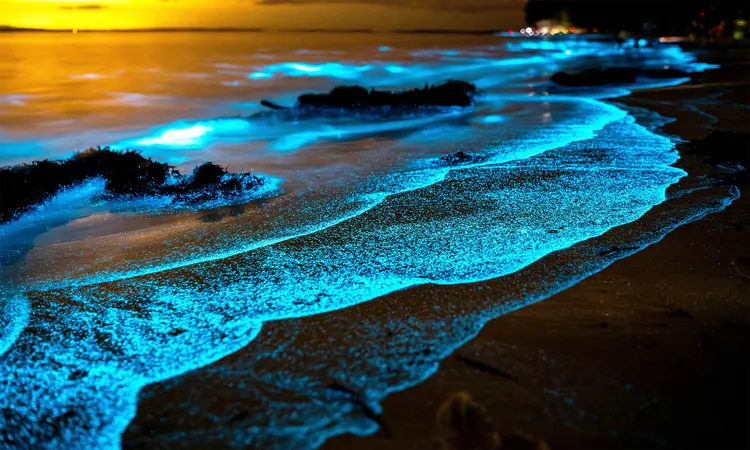
The Enigmatic Glow of 'Milky Seas': A 400-Year Mystery Finally Unveiled?
2025-04-14
Author: Liam
A Celestial Sea Mystery Awaits Unraveling
For centuries, sailors venturing across the world's vast oceans have reported a mesmerizing sight: expansive waters illuminating the night sky with a soft white or greenish glow. These captivating areas, known as "milky seas," are so radiant they can light up a ship's deck and even be detected from space, spanning regions as large as 100,000 square kilometers.
The Quest for Scientific Understanding
Researchers at Colorado State University (CSU) have embarked on a groundbreaking project, compiling an extensive database from 400 years of sailor accounts, data from the Marine Observer Journal, and satellite imagery. Their goal? Transform age-old folklore into scientific fact and uncover the connection between these luminous phenomena and broader Earth systems.
Bioluminescence: The Role of Vibrio harveyi
Despite countless reports over the years, the origin of milky seas remains a baffling enigma. Leading the charge in this exploration, Justin Hudson, a PhD student at CSU, posits that the glow may stem from Vibrio harveyi, a bioluminescent bacterium capable of thriving in vast blooms under specific conditions. However, obtaining solid data on these rare occurrences has proven difficult, as they predominantly appear in the secluded Indian Ocean.
A solitary photograph from a yacht in 2019 is the only evidence captured at sea level, leaving researchers eager to delve deeper into these luminous waters.
From Tall Tales to Tangible Evidence
Hudson's team meticulously cataloged milky sea sightings dating back to the 17th century, linking historical reports with satellite imagery and known climate patterns. They found that the majority of milky sea phenomena occur around the Arabian Sea and Southeast Asia, correlating with significant climatic events like the Indian Ocean Dipole and the El Niño Southern Oscillation.
With nearly 60% of all documented events hailing from the northwest Indian Ocean near Somalia and Socotra, deeper biological activity seems tied to evolving phases of the Indian monsoon.
Biology and Environment Intertwined
While bioluminescence is observed in various organisms such as fireflies and jellyfish, milky seas are unique for their massive scale and enduring illumination. One of the rare insights into their biology arose from a 1985 research vessel that inadvertently sailed through a milky sea and gathered samples revealing luminous bacteria clustered around algae.
Despite having only one sample to reference, Hudson aims to send research expeditions to study these areas accurately. Successful predictions of future events using the new database might enhance their chances of timely exploration.
Unlocking Nature's Secrets
Professor Steven Miller, Hudson's advisor, has long been captivated by milky seas and has contributed to satellite imaging efforts. He believes that understanding these natural wonders goes beyond solving centuries-old riddles—it's about uncovering vital components of our planet's biosphere.
"Milky seas highlight extraordinary interactions between the Earth's surface and atmosphere, illustrating the microscopic roles of bacteria in our global systems," Miller states.
A Bright Horizon for Future Research
As Hudson gears up to present his thesis, he envisions this research unlocking new pathways that intertwine climate science, biology, and oceanography. "We still have much to learn about the ecological implications of milky seas. Do they signify healthy ecosystems or distress? The bacteria involved are known to disrupt local marine life, which raises important questions," he reflects.
With new data at their disposal, researchers hope to answer critical questions about these luminous waters, no longer relying on chance encounters to study them. This pivotal research has been chronicled in the journal Earth and Space Science.









 Brasil (PT)
Brasil (PT)
 Canada (EN)
Canada (EN)
 Chile (ES)
Chile (ES)
 Česko (CS)
Česko (CS)
 대한민국 (KO)
대한민국 (KO)
 España (ES)
España (ES)
 France (FR)
France (FR)
 Hong Kong (EN)
Hong Kong (EN)
 Italia (IT)
Italia (IT)
 日本 (JA)
日本 (JA)
 Magyarország (HU)
Magyarország (HU)
 Norge (NO)
Norge (NO)
 Polska (PL)
Polska (PL)
 Schweiz (DE)
Schweiz (DE)
 Singapore (EN)
Singapore (EN)
 Sverige (SV)
Sverige (SV)
 Suomi (FI)
Suomi (FI)
 Türkiye (TR)
Türkiye (TR)
 الإمارات العربية المتحدة (AR)
الإمارات العربية المتحدة (AR)